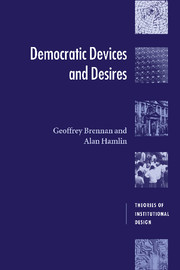Preface and acknowledgements
Published online by Cambridge University Press: 22 September 2009
Summary
This book has its origins in a number of joint papers written over an extensive period. The first of the relevant papers to appear was published in 1992, and since then there have been around eight further papers, all connected in one way or another to the questions of institutional design with which this book is also concerned. Traces of this earlier work can be found in various places in the text that follows, but the current book is much more than a refiguring of the earlier papers. Indeed, it is much less a refiguring than we had originally imagined it would be. Books often have a way of taking on a life of their own and this was certainly so in the present case. As we indicate in the initial chapter, the basic intention of the book changed shape as the enterprise developed. The intellectual scheme laid out originally in the paper ‘Economising on virtue’ (Constitutional Political Economy, 1995) took on a larger and larger place in our thinking and rendered much of our earlier treatment of topics like the separation of powers (Journal of Theoretical Politics, 1994) and bicameralism (Public Choice, 1992) seriously incomplete. Thus, what was to have been a book on ‘devices’ became much more a book on ‘desires’ and on the connection between devices and desires.
- Type
- Chapter
- Information
- Democratic Devices and Desires , pp. ix - xPublisher: Cambridge University PressPrint publication year: 2000



